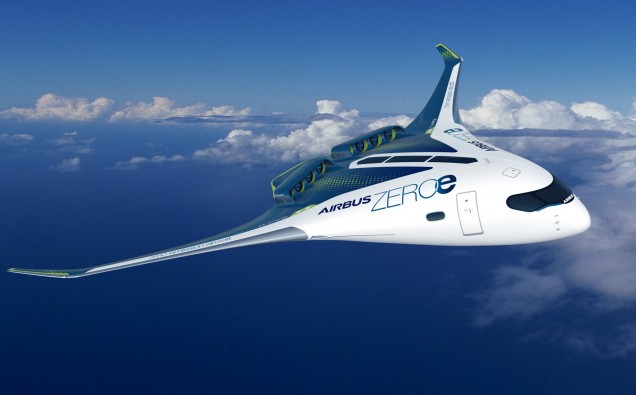The biggest step taken by Airbus to build their future aircraft is based on Zero Emission Concept which will protect the environment and climate with the use of hydrogen as their main player. Hydrogen is a component which is used in many industries to meet their climate targets. From decades it’s mostly used by many automobile and aerospace industries and now airbus is taking this component in their commercial aircraft by 2035. The plan is already in action, airbus revealed three concepts for the world’s first Zero Emission. All three concepts are condenamed “Zeroe” for a first climate neutral Zero emission commercial aircraft include:-
1.) Turbofan Design – Which is designed for 120-200 passengers with a range of 2000 + nautical miles. It is powered by a modified gas turbine engine running on hydrogen rather than jet fuel through combustion. Liquid hydrogen will be stored and distributed via tanks located behind rear pressure bulkhead which is capable of operating Transcontinentally.
2.) Turboprop Design: – It is for taking 100 passengers powered by hydrogen combustion in modified gas turbine engines capable of traveling more than 1000 nautical miles making perfect option for short haul trips. This design is using turboprop engine instead of turbofan.
3.) Blended Wing body: – Designed for 200 passengers, this concept is new and unique including wings merge with the main body of the aircraft. Its range is similar to the turbofan concept.
These concepts rely on hydrogen. According to Guillaume Faury CEO of Airbus, “This is a historic moment for the commercial aviation sector as a whole and we intend to play a leading role in the most important transition this industry has ever seen. The concepts we unveil offer the world a glimpse of our ambition to drive a bold for the future of Zero emission flight. I strongly believe that the use of hydrogen both in synthetic fuels and as a primary power source for commercial aircraft has the potential to significantly reduce aviation’s climate impact.”
These three designs are the solutions to clean the climate and aim to decarbonize the aviation industry. Though this requires a heavy investment and various technological methods. According to the Airbus Media Press report, “In order to tackle these challenges, airports will require significant hydrogen transport and refuelling infrastructure to meet the needs of day-to-day operations. Support from governments will be key to meet these ambitious objectives with increased funding for research and technology, digitalisation, and mechanisms that encourage the use of sustainable fuels and the renewal of aircraft fleets to allow airlines to retire older, less environmentally-friendly aircraft earlier.”
Target is set in 2020 to meet the goals of 2035 by Airbus. To protect the environment and climate they have to build their future for the flights now.
By: Rida Khan ( Aviation Author)
Instagram A/c :- aviationauthor.ridakhan


















